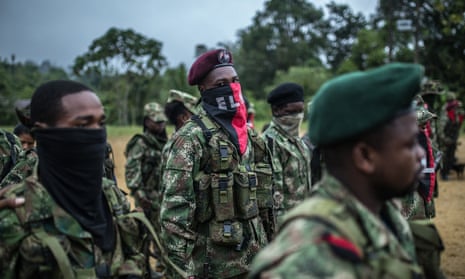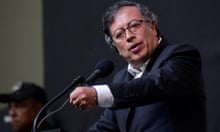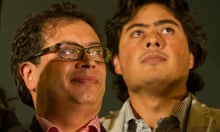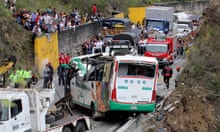In the humidity of the Colombian jungle, a rebel fighter known as Davidson shows more than 100 fellow insurgents how to build an anti-personnel landmine from a plastic canister, a syringe, a battery, and what he calls “a few secret ingredients”.
Davidson is an explosives expert for the National Liberation Army (ELN), Colombia’s largest rebel army following last year’s landmark peace deal and demobilisation of the Revolutionary Armed Forces of Colombia (Farc).
At its peak, the Farc was present in almost a third of Colombia’s territory, but the ELN has historically been a smaller group and currently has an estimated 2,000 fighters. In the regions where it holds sway, however, the ELN remains a powerful actor.
Although the group has been involved in a halting dialogue with the Colombian government since February 2017, there is a yawning gulf between the government’s position and the ELN’s demands for radical social and economic change.
A temporary ceasefire that came into force in October is due to end on 9 January – and although negotiations are due to restart this month, both sides are preparing for conflict.
Watching the landmine demonstration is Estacio, who joined the rebels 13 years ago. “The future has to be about war,” he says. “The government believes peace can be achieved by silencing our weapons. But peace is achieved with the people. Our struggle will have to continue until they realise that.”
According to Estacio and other rebels, armed resistance is one of the ELN’s core principles and expecting them to give that up without the changes they are fighting for is pointless.
Estacio belongs to the Ernesto Che Guevara Front, which dominates the south of Chocó, an impoverished Pacific coast region of dense jungles and rivers.
One of the unit’s commanders, who goes by the nom de guerre “Uriel”, says that, unlike the Farc, which now says it will seek change as a legal political party, the ELN are still seeking a peace deal which attacks the root cause of the conflict: poverty.
“If the enemy’s objective is to demobilise us, we are wasting our time. We have tried to convince the government on several occasions that if they want to stop the guerrilla, they need to take away the arguments for our existence,” he says.
Chocó is one of the country’s poorest regions: riverbanks are lined with wooden shacks, many on stilts to protect them from flooding. Poverty is endemic, and the region’s mostly Afro-Colombian and indigenous population depends on subsistence agriculture.
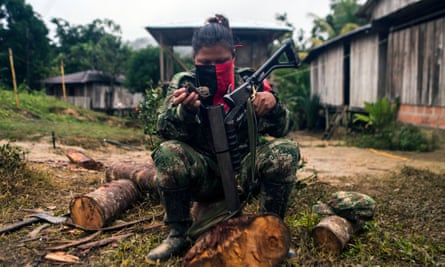
Community leaders complain that so far they have seen no benefits of the peace process. Residents bathe, wash their pots and go to the toilet by the side of the river. Electricity is rationed to just a few hours each evening and at 10pm, the river falls dark.
But in contrast to the surrounding poverty, the San Juan river is a key part of a multi billion-dollar industry: the vast waterway is a strategic route for drug traffickers, linking coca production zones to the Pacific coast from where shipments of cocaine are dispatched to the market.
The Farc demobilisation created new criminal opportunities for the ELN to expand their role in the drugs trade. But they have competition from a network of former rightwing paramilitaries and urban gangs known as the Gaitanista Self-Defence Forces, or AGC.
The AGC, also known as the Urabeños, the Gulf Clan and the Úsugas, control the north of the San Juan, where they keep a permanent armed guard at a stronghold a few hours upriver . Their camouflage and rifles are visible from the vessels that pass by.
The central section of the river belongs to the ELN; but in the southern delta the ELN and AGC fight for control.
Caught in the crossfire are the riverside communities. In Chocó, 60% of the population are registered as victims of the conflict, according a 2017 report from Amnesty International.
On 25 October, the ELN murdered the indigenous community leader Aulio Ismará, causing 309 members of his community to flee their homes. The rebels claim Ismará had links to military intelligence and they had planned to interrogate him, but he ran away.
The ELN has been accused of several other infringements of the ceasefire since it came into force – all of them against the civilian population or other criminal groups rather than the military.
In March, five members of the same family were murdered in the small village of Carra by men with ELN armbands. Four victims were shot dead; another reportedly drowned while trying to escape.
The attack happened shortly after an AGC unit had spent the night in Carra, and witnesses said the rebels accused their victims of collaborating with the paramilitaries.
Just three days later, two AGC gunmen turned up in the community of Cab eceras on the opposite side of the river. They wanted to permanently station a 10-man patrol in the village, but the community refused.
“Then the ELN turned up warning us not to cooperate with the paramilitaries,” says one of the residents. “We held a meeting of the entire village and we decided unanimously to leave.”
The village’s 119 residents fled to the city of Buenaventura, where since April 2017, they have lived in the city’s sports hall, and relying on handouts from the local council.
“All communities in San Juan are under threat,” says the resident, who asked not to be named. If you talk to the ELN or the paramilitaries, the other accuses you of being an informant.
“The river is public. Let them use it. We don’t care what they do. But they need to leave us and our communities alone.”
The San Juan river communities voted overwhelmingly in favour of peace in the 2016 referendum called by the president, Juan Manuel Santos, to ratify the deal with Farc – and they feel betrayed that the government did not make better preparations for the vacuum it has created.
“The president won a Nobel peace prize, but massacres continue, the persecution continues,” said one of the residents. “This is not the peace we want. We need a peace that allows us to be safe in our own homes. We need to be able to live, work and study without the fear of violence.”
